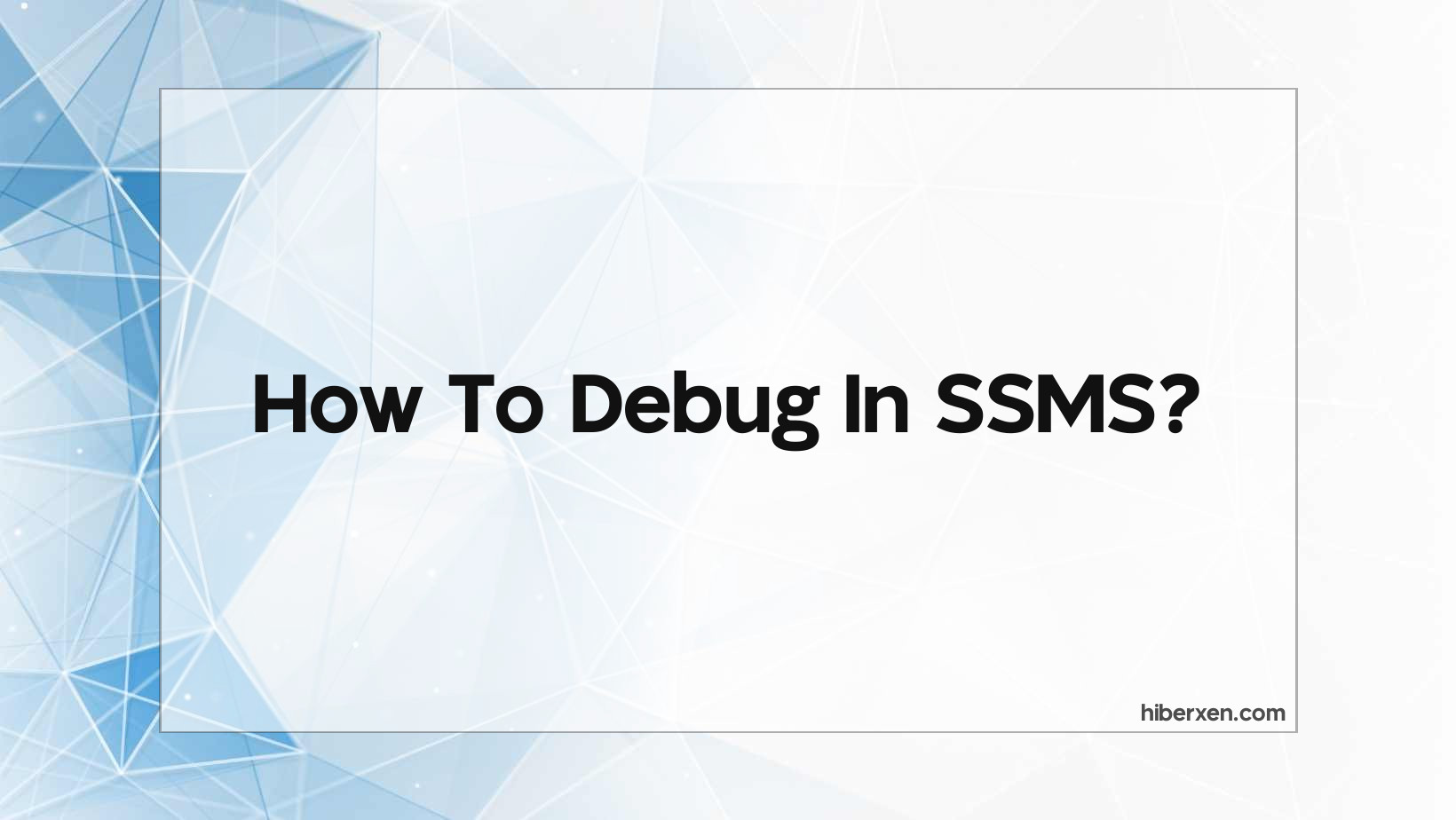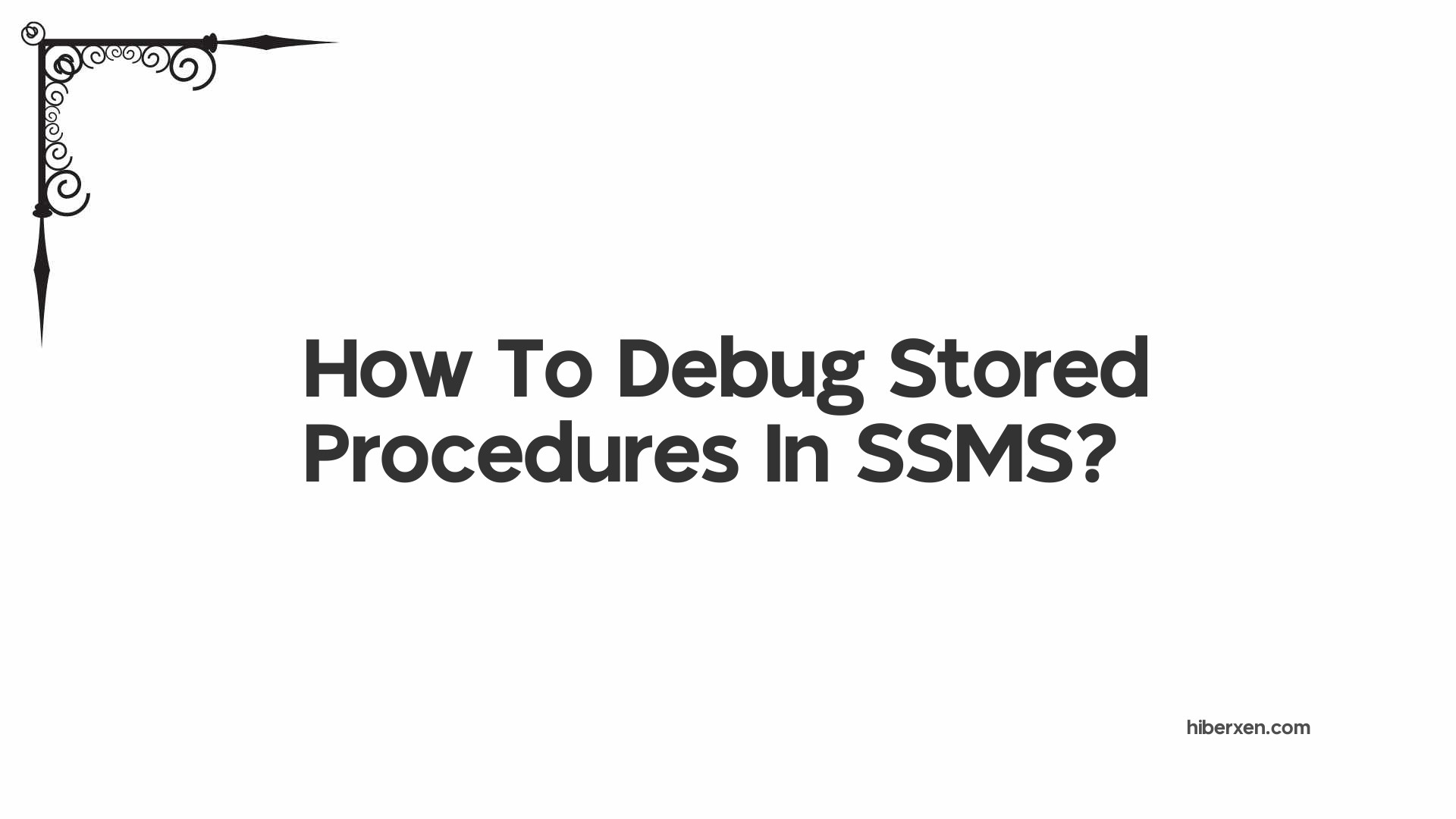Open the SSMS Debugger from the Tools menu.
When it comes to debugging in SSMS, there are a few different options that you have available to you. First, you can use the built-in debugging tools that are available within SSMS. These tools can be found under the “Debug” menu, and they allow you to step through your code line by line, set breakpoints, and watch the values of variables as your code executes.
Another option for debugging in SSMS is to use the SQL Server Profiler. This tool can be used to trace the execution of your code, and can be very helpful in identifying where errors are occurring. The SQL Server Profiler can be found under the “Tools” menu.
Finally, you can also use the Windows Event Viewer to look for any error messages that might be generated by your code. The Event Viewer can be found under the “Administrative Tools” menu.
Debugging in SSMS can be a bit tricky, but with these tools at your disposal, you should be able to find and fix any errors that might be occurring in your code.
How To Debug Stored Procedures In SSMS?
In SSMS, open the stored procedure that you want to debug, and then press F5.
Debugging stored procedures can be a pain, but there are a few ways to make it easier. First, make sure that you have the latest version of SQL Server Management Studio (SSMS). Next, open the stored procedure in SSMS and click on the Debug menu. Then, click on the Start Debugging option.
If you’re still having trouble, try setting a breakpoint in the stored procedure. To do this, click on the line of code where you want to break and then press F9. This will cause the stored procedure to stop running at that line, which will give you a chance to see what’s going wrong.
If you’re still having trouble, try reaching out to a developer or DBA for help. They may be able to give you some tips on how to debug the stored procedure.
How To Debug SQL Queries In SSMS?
There is a debug button in the query window in SSMS.
1) Breakpoints
2) The Immediate Window
Breakpoints
Breakpoints allow you to specify a line of code where execution will pause. This is useful when you want to see what value a variable has at a certain point in the code, or if you want to step through the code line by line to see what’s happening.
To set a breakpoint, open SSMS and the query you want to debug. Then, click on the line of code where you want execution to pause and press F9, or right-click and select Breakpoint > Insert Breakpoint.
Now, when you execute the query, execution will pause at the breakpoint. To step through the code, press F10 to move to the next line, or F11 to step into a function.
The Immediate Window
The Immediate Window is a tool that allows you to execute code one line at a time. This is useful when you want to test a piece of code without running the entire query.
To open the Immediate Window, press Ctrl+Alt+I.
Now, type the code you want to execute and press Enter. The code will execute and return any results.
For example, if you have a query that returns a list of customer names and you just want to see the first few names, you can use the Immediate Window to do this:
SELECT TOP 10 * FROM customers
This will return the first 10 rows from the customers table.
How To Debug SSIS Packages In SSMS?
In SSMS, under the SSIS menu, choose SSIS Debugger.
SSIS packages can be debugged in Microsoft SQL Server Management Studio (SSMS) by following these steps:
1. Open SSMS and connect to the SQL Server instance where the SSIS package is deployed.
2. Expand the “Stored Packages” folder and double-click on the package to open it.
3. In the SSIS package editor, click on the “Debug” menu and select “Debug Package” or “Debug Project” to start debugging.
4. The SSIS package will start running and break at the first breakpoint. To view the data in the variables and data flow, click on the “View” menu and select the “Variables” or “Data Flow” option.
5. To continue execution of the SSIS package, click on the “Debug” menu and select “Continue” or press F5.
6. To stop debugging, click on the “Debug” menu and select “Stop Debugging” or press Shift+F5.
Example:
Suppose we have an SSIS package that imports data from a CSV file into a SQL Server database table. The package has a data flow task with a CSV data source and a SQL Server destination. We have set a breakpoint on the data flow task so that we can debug the package.
When we start debugging, the package will break at the breakpoint. We can then view the data in the CSV file by expanding the “Variables” window and clicking on the “Data” tab. We can also view the data in the SQL Server database table by expanding the “Data Flow” window and clicking on the “Preview” tab.
If we want to continue execution of the package, we can click on the “Debug” menu and select “Continue” or press F5. The package will then continue running and end successfully.
How To Debug SSRS Reports In SSMS?
To debug an SSRS report in SSMS, open the report in Visual Studio, set a breakpoint on the design surface, and then run the report from SSMS.
If you’re looking for a way to debug your SSRS reports, you’ve come to the right place. In this article, we’ll show you how to debug SSRS reports in SSMS.
First, open up SSMS and connect to your SQL Server instance. expand the “Security” node, right-click on the “Logins” folder, and select “New Login…”
In the “Login – New” dialog, enter the name of the Windows user account that you want to use to debug the reports. Under the “Default database” drop-down, select the database that contains the reports.
Click “OK” to save the new login.
Next, open the report server in Internet Explorer. In the left-hand navigation pane, expand the “Site Settings” node and click on “Security”.
In the “Security” page, click on the “New Role Assignment” button.
In the “New Role Assignment” dialog, select the Windows user account that you created in the previous step from the “User or Group” drop-down. Under the “Role” drop-down, select the “Report Builder” role.
Click “OK” to save the new role assignment.
Now, open the report that you want to debug in Visual Studio. In the “Solution Explorer” pane, right-click on the report and select “Properties”.
In the “Properties” window, select the “Debug” tab. In the “Start Options” section, select the “Launch in browser” option.
Click “OK” to save the changes and close the “Properties” window.
Now, when you start the debugger, the report will open in Internet Explorer. You can set breakpoints and step through the code just like you would with any other type of debugging.
Happy debugging!
How To Debug SSAS Cubes In SSMS?
Use the Cube Designer in SSMS to open the cube and then use the Process option to process the cube.
It’s not uncommon for Analysis Services (SSAS) cubes to have issues that need to be debugged. In this article, we’ll show you how to debug SSAS cubes in SQL Server Management Studio (SSMS).
First, open SSMS and connect to your Analysis Services server. Then, open the Cube Browser window.
To do this, right-click on the cube that you want to debug in the SSAS Database list and select Browse.
In the Cube Browser window, you’ll see a list of dimensions and measures. Select thedimension that you want to debug.
Then, in the dimension list, select the measure that you want to debug.
Next, click on the Run button.
The debugger will start and you’ll see the first line of code that will be executed.
Click on the Step Into button to execute the line of code.
The debugger will move to the next line of code and so on.
You can also click on the Step Over button to execute the line of code and move to the next line without stopping at each line.
Once you’ve finished debugging, click on the Stop Debugging button.
And that’s how you debug SSAS cubes in SSMS!
FAQ
How To Debug SQL Server Agent Jobs In SSMS?
1. Right-click on the job and select “View Job History”. This will open a window that shows the job’s history, including any errors that have occurred.
2. In the “SQL Server Agent” node, expand “Jobs”, then find the job you want to debug and double-click it. In the job’s properties window, select the “Steps” tab. Here you can see the individual steps in the job and any errors that have occurred for each step.
3. Another way to debug a SQL Server Agent job is to run it in “verbose” mode. To do this, right-click on the job and select “Properties”. In the job’s properties window, select the “Advanced” tab and check the “Include step output in history log” option. This will cause the job to run in verbose mode and output any errors to the job’s history log.
How To Debug SQL Server Integration Services Packages In SSMS?
One way is to set breakpoints on the tasks in the package. To do this, open the SSIS package in SSMS, click on the Control Flow tab, and then click on the task you want to set a breakpoint on. In the Properties window, set the BreakPoint property to True.
When you run the package, it will stop at the breakpoint and you can then step through the package to see what is happening.
Another way to debug a SQL Server Integration Services package is to use logging. This will allow you to see what is happening inside the package as it runs. To do this, open the SSIS package in SSMS and click on the Logging tab. Select the events that you want to log, choose where you want the log to be written to, and then click OK.
When you run the package, the log will be written and you can review it to see what is happening inside the package.
How To Debug SQL Server Reporting Services Reports In SSMS?
How To Debug SQL Server Analysis Services Cubes In SSMS?
1. Use the Cube Browser to view the data in the cube and identify any errors.
2. Use SQL Server Profiler to trace the cube processing and identify any errors.
3. Use the Cube Structure window to view the cube schema and identify any errors.
Conclusion
If you are having trouble debugging in SQL Server Management Studio, there are a few things you can try. First, make sure you are using the latest version of SSMS. Then, check the SSMS documentation for troubleshooting tips. If you still can’t get it to work, you can post a question on the SSMS forum.
If you are still having trouble understanding how to debug in SSMS, please let us know in the comments section below.
Author
-
I'm Shahrear, a Designer Lead who loves electronics. Since 2003, I’ve been traveling and living all over the world. I love breaking down complex concepts in electronics and presenting them to others in an approachable way. I think that the language used in most books about electronics is hard for people who don't already know about electronics to understand. I want that to change. So, I've started blog where I talk about everything on electronics for people who are just starting out.
View all posts






